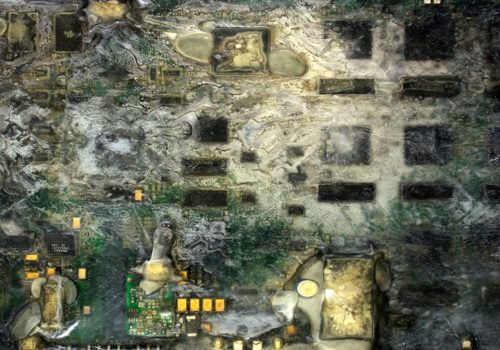Exchange
Computer componentry is a defining symbol of the global digital revolution.
Although unregulated by traditional social hierarchies, as barriers to entry are increasingly broken down, access to the latest digital devices and networks are still constrained by location and affordability. In addition, systems often promote the obfuscation of information through complexity.
Despite this, the documentation of our personal visual memories and artifacts are increasingly archived in networked databanks held by commercial interests, often recycled and re-interpreted through social media platforms. *
The consolidation of these online databases has created tenuous links for future ownership of our digital possessions, as we negotiate rapidly changing environments in which to gather and conserve information.
How will digital images and artefacts, currently accessible, be rediscovered by future generations?
How will decades of treasured personal memories be catalogued for retrieval without universally agreed protocols?
What obligations do we have to identify and conserve important online platforms for historical purposes and by what mechanisms should we address this challenge?
What does the ongoing obsolescence of the digital environment signify about our insatiable quest for rapid technological advancement?
The series EXCHANGE has been created by the initial photographing of large computer motherboards similar to those used in telecommunications, which have been immersed to create abstract images, reminiscent of the finding and uncovering of lost relics in an archaeological site, which have been frozen in time.
The original digital files of these images were then corrupted in the process of computer translation to create a second image. The third image was subsequently created by montaging of the uncorrupted and corrupted files, completing the triptych.
Heather Fernon
*International Data Corporation (IDC) estimates that by 2025 the global data sphere will grow to 163 Zettabytes. A zettabyte is a trillion gigabytes.
















